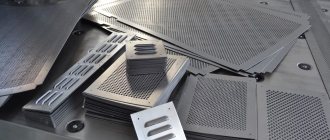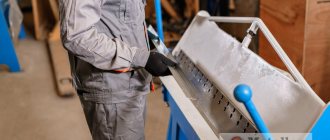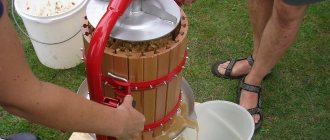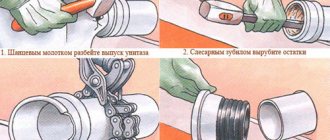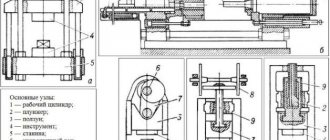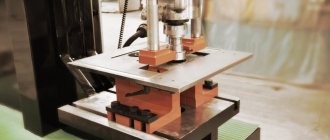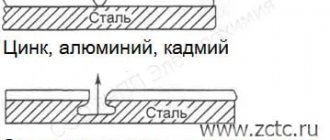A creasing machine is specialized equipment that allows you to perform such a technological operation as creasing. This method of processing, which sheet metal blanks are subjected to, is not particularly difficult in technological terms, but to carry out such processing it is necessary to use special machines. Such equipment, presented on the modern market in a wide variety of serial models, can be equipped with a manual, electric or hydraulic drive. If desired, it is easy to make a simple crimping machine with your own hands.
Operation of a seaming machine: applying a double round seam to a cylindrical workpiece
Short description
Applying a kind of relief pattern to the surface of thin sheet metal is carried out using special equipment called a zig machine. It is equipped with a pair of rollers, which during operation make corresponding ridges (grooves), which can be not only flat, but also three-dimensional types of workpieces.
In addition, with the help of this mechanism, corrugation, cutting, and flanging of sheet metal are carried out. This type of zigging machines is presented in several varieties, these are manual and electric zigging machines. But there is also a hydraulic one, but it is mainly used in large industrial enterprises.
According to the principle of application, they are no different, except that manual machines produce corrugation of a metal sheet with a thickness of 0.3 to 1.0 mm. But electric ones have a lot of power, so they can apply reliefs on a metal surface of more than 2.0 mm.
In principle, all types of beading machines are not very different from each other, but they have different capacities. In addition, these shafts can have different locations, for example, horizontal, vertical and inclined positions. Rollers with the required relief are put on them directly.
Classification of serging equipment by drive type
The simplest, both in its design and in its operating principle, is the manual zigovochny machine. All manipulations with such equipment, as its name suggests, are carried out manually. Such manipulations, in particular, include: pressing shafts with working rollers, for which a special handle located in the upper part of the device is used; scrolling the rollers together with the workpiece sandwiched between them: this action is also performed using a special lever-type handle.
To effectively use the simplest manual type crimping machine, certain skills and dexterity are required, since its operator must simultaneously turn the handle and hold the workpiece in the required position, thereby using both hands. Due to the low power of the drive installed on it, a manual creasing machine can be used for processing sheet blanks whose thickness does not exceed 1.5 mm.
Manual crimping machine is suitable for occasional use in the home workshop
A more powerful, productive, but also more expensive in terms of cost is an electrically driven staking machine. Such zigging machines are most correctly classified as electromechanical equipment, since their design also includes a manual mechanical drive, which ensures compression of the sheet workpiece between the working rollers. Due to the electric drive of such equipment, the working rollers rotate and, accordingly, the rotational movement of the workpiece being processed.
The electric drive of the machine is switched on and off using a foot pedal, so that both hands of the operator always remain free to manipulate the workpiece. The presence of an electric drive, which is equipped with such beading machines, as mentioned above, significantly increases their productivity, which makes it possible to successfully use these machines to equip enterprises producing metal products in large batches. In addition, the power of such a machine allows it to be used for processing sheet metal workpieces, the thickness of which reaches 5 mm.
Electromechanical creasing machines, as a rule, can be equipped with additional devices for processing workpieces of complex configurations
Sealing machines can also be equipped with a hydraulic drive, which further increases the power of the equipment. The technical capabilities of such machines make it possible to successfully use them for processing sheet metal of even fairly significant thickness. The hydraulic drive of this type of beading equipment is responsible for pressing the working rollers to the surface of the workpiece, and their rotation and, accordingly, the movement of the workpiece is provided by an electric drive mechanism. Despite all the advantages that hydraulic crimping machines have, they also have disadvantages: large overall dimensions and significant weight, which is why such equipment is mainly used by large manufacturing enterprises.
Brief characteristics of the zigging mechanism
Depending on the type of production, such equipment has a wide range of actions, which makes it possible to crimp sheet metal with the appropriate relief.
Specifications:
| Characteristic | Values |
| Drive type | Manual, electromechanical and hydraulic |
| Roller diameter | From 50 mm |
| Roller overhang | If special work is to be performed, it is necessary to select an indicator with a maximum shoulder reach (up to 350 mm) |
| Number of additional pairs of rollers | Often it is 4 or 6 or 9 pairs |
| Metal thickness | From 0.5 to 4 mm |
| Dimensions of the zig machine | All types of crimping machines take up little space, even hydraulic ones |
| Zig machine weight | Depending on the type of mechanism, weight can vary from 10 to 300 kg |
Processing Features
Special zigmachines are used to corrugate the surface of thin sheet metal. This device is equipped with a pair of shafts, which, when rotated, press on the metal, forming grooves of a given size and configuration. The workpiece can be either flat or three-dimensional; in addition to corrugation, sheet blanks are cut and flanged.
The sigmachine can have a manual, electric or hydraulic drive. The operating principle is the same for any drive, but there are differences in the thickness of the workpiece. For a manual drive, this parameter ranges from 0.3 to 1 mm; for electric machines, the maximum thickness can reach 4 mm. In addition, the equipment differs in the arrangement of the shafts, which can be horizontal, inclined or vertical.
Main purposes of serging equipment
Such machines, according to their intended purpose, are used for work related to tin materials that have a cylindrical shape. Therefore, it is very often used to increase the strength of a metal product, as a connecting profile, and is also used in the form of processing the edges of sheet metal. In addition, it is used:
- In the production of cylindrical products in the form of ventilation and water pipes.
- With its help, special locks are made on metal products made of thin iron, which makes it easy to connect various iron parts without the use of welding equipment.
- In the production of thermal insulation of pipelines.
- Often used in the processing of shells.
- In roofing work for cutting and flaring drainpipes.
- In the production of ventilation shaped parts.
- It is also used in the production of components for drainage systems.
But the most common application of zig machines is the process of corrugating thin-sheet material that has a cylindrical shape.
Features of the technological process
Metal beading is an easy operation to perform, but it requires some skills and knowledge of the technological process. Since, thanks to heaving, softer material acquires greater strength, it is necessary that the elements are made with high quality. To do this, you need to know how the process of applying relief occurs. It is as follows:
- The upper roller is raised onto the lower one to place the part for processing and then the raised upper roller is lowered onto it.
- It is very important that during the zigging process uniform corrugations are applied and the distance is taken into account, so it is imperative to use a stop.
- The degree of fixation of the workpiece is adjusted using the existing screws.
- Another feature is that if you use a more durable material, you need to take into account that for creasing in this case it is necessary to use a hydraulic or electric drive on the equipment.
- For example, if corrugation is used on aluminum or zinc materials, then it is necessary to increase the distance between the ridges, as well as increase the radius of the ridge itself.
- The shafts with corresponding rollers have the opposite effect during operation, that is, they rotate in the opposite direction, which as a result creates the necessary depressions on the sheet metal.
If the first time applying relief to thin-sheet metal was not done enough, then you can carry out several more cycles along the already completed zigs. Only after achieving the desired result can the workpiece be removed.
Areas of application for creasing equipment
Equipment designed to perform beading, even though the name of such a technological operation is familiar mainly to metalworking specialists, is actively used in various fields of activity. Sealing machines are practically indispensable for the manufacture of elements of roofing structures, in particular, for the formation of their edges.
Examples of drainage elements made on a crimping machine
It should be noted that in the construction industry, bending machines have found very wide application. Using such machines, in particular, the following elements of building structures and communication systems are made from sheet metal: parts of drainage and air duct systems, insulation for heating mains, etc. In the construction industry, manual staking equipment is predominantly used, since it is characterized by its small dimensions and insignificant weight, does not require an electrical supply for its operation and can be used almost anywhere.
The creasing machine can also be used to reliably connect cylindrical workpieces made of thin sheet metal together. Rollers for equipping a zig machine of this type, when a cylindrical workpiece passes through them, form locks on it, with the help of which the two parts are connected.
Rolling the lock on the air duct elbow
When making connections using locks, unlike welding, there is no thermal effect on the metal parts, which eliminates the possibility of their warping. In addition, such a machine, which you can also make yourself, does not require any additional consumables for its use.
To expand the functionality of a staking machine, including a manual one, it can be equipped with additional working parts. Machines equipped in this way can be used not only as creasing equipment, but also as bending and profiling equipment. Modern creasing machines for industrial use are often equipped with automated control systems, which increases their productivity and accuracy of technological operations performed with their help.
Special attachments allow you to make folds for connecting thin-walled pipes
Advantages
Regardless of the type of creasing equipment, they all have their own advantages, which allow the necessary work to be carried out with a high level of quality. These include:
- If you take a manual zig machine, then it is economical, since it does not require any financial costs other than physical strength. Also, its mobility allows you to carry out work in a convenient place without using electricity.
- In addition, the small dimensions of the mechanism allow the use of a minimum amount of space for its placement.
- With its help, it is possible to produce various corrugations on the surface of sheet metal with high quality, thereby increasing its strength.
- As for stationary zig machines, they also do not take up much space, but the mobility of such equipment is lacking.
- Directly one of the advantages is the fact that with the help of crimping you can connect parts of products without the use of welding or other similar methods.
- The quality of the products produced is correspondingly higher, and, importantly, it is possible to use a material with a more solid structure, but with sufficiently high ductility, which, in turn, allows work to be carried out without damaging the sheet material.
- In addition, the aesthetic appearance of the product increases.
In any case, such equipment makes it possible to produce parts with the necessary corrugation, especially if you consider that today there are a large number of varieties of ridge application of relief on sheet material.
As for the disadvantages, the only one is that when manually beveling sheet metal, you will need to put in quite a lot of physical labor, but this in no way affects the quality of the work performed.
How to make a crimping machine with your own hands?
First of all, you need to determine for yourself for what purpose this mechanism will be used, and how often it will need to be used. This is due to the fact that the zig machine is not a popular tool for daily use at home. But, if it is the object of professional activity, then you can do it yourself.
To create such a machine you will need to collect all the necessary parts. And, most importantly, every man who has even the slightest connection to technology can have them. The main parts that will be needed to make a zig machine:
- bracket;
- two working shafts;
- cylinder shank;
- device body;
- protective casing;
- spring device;
- locking pin;
- gear parts;
- rollers.
It is necessary to secure the beading machine using a special screw, but this must be done so that the shank of the main mechanism fits into the bracket. As for the body of the device, it needs to be secured well using a locking pin. To adjust the movement of the shafts, there must be a handle.
The rollers themselves on a homemade zig machine are driven by another handle and a toothed belt mechanism. A very important point in creating such equipment at home is that it is necessary that all parts of the gear mechanism be covered with a special protective casing.
Video: zigovka – electromechanical zigovka machine.
What do you need to know when working with a homemade zig machine?
A zig machine made independently is no different in operating principle from a factory machine, but still has some nuances that must be taken into account. These are such as:
- The part to be processed must be very securely fixed.
- The prepared workpiece must be placed between the rollers and secured with a special stop.
- The process involves adjusting the upper roller, which is operated by a handle.
To avoid injury, be sure to cover all parts of the rotating mechanism with a protective cover. One of the most important advantages of this equipment is that when used, the material used is not exposed to high temperatures.
And also no additional financial costs are required, for example, there is no need to use fuel or large amounts of electricity. And if you use a manual zig machine, then only physical strength is required.
Republished by Blog Post Promoter
Extracting precious metals at home
Gold (Au)
Gold is obtained by amalgation or leaching.
During amalgamation, gold dissolves in mercury (Hg), forming an amalgam, which becomes solid if the Au content is more than 15%. From the resulting amalgam, mercury is distilled off in condensing devices, leaving Au and Ag (silver) nodules. Purification of Au from silver is discussed below. For leaching , a solution of sodium or potassium cyanide is used - NaCN or KCN (concentrated solution in distilled water), in which Au dissolves in the presence of oxygen (by blowing with air) to form complex anions [Au(CN)2] - - potassium dicionate:
4Au + 8CN - + O2 + 2H2O = 4[Au(CN)2]- + 4OH-
From the resulting solution, gold is isolated with metallic zinc (Zn filings) into a colloidal precipitate:
2[Au(CN)2]- + Zn = [Zn(CN)4]2 — +2Au
The precipitated gold is treated to separate the zinc from it with dilute sulfuric acid; washed and dried.
Further purification of Au from impurities (mainly silver) is carried out by treating it with hot concentrated sulfuric acid H2SO4 or electrolysis is required.
Au also easily dissolves in “aqua regia” (a 1:4 mixture of hydrochloric HCl and nitric acids HNO3), forming complex chloroauric acid H[AuCl4], which crystallizes upon evaporation in the form of light yellow needles of the composition H[AuCl4]•4H2O.
Au also easily dissolves in “chlorine water” and in aerated, i.e. purged with air, solutions of alkali metal cyanides.
All Au compounds readily decompose when heated, releasing metallic Au.
Due to its softness, Au is used in alloys, usually with silver or copper. These alloys are also used for electrical contacts.
Working with these reagents requires GREAT CAUTION, as they are all deadly poisonous.
The presence of Au in radio components is determined by the part's passport and the characteristic color of the coatings.
Silver (Ag)
Silver is obtained by amalgation or leaching. In leaching, silver is dissolved by the action of a concentrated solution of potassium cyanide KCN or NaCN in distilled water. From the resulting complex cyanide compound K[Ag(CN)2], Na[Ag(CN)2], metallic silver is deposited by passing electric current through the solution ([Ag(CN)2]- ? Ag+ 2CN-), a dense metal-ceramic crystalline layer at the cathode.
Hydrochloric and dilute sulfuric acid have no effect on Ag. Silver dissolves well in nitric acid HNO3, so nitric acid is used to separate Ag from gold Au, which does not dissolve in HNO3:
Ag + 2HNO3 = AgNO3 + NO3? + H2O.
All Ag compounds are easily reduced under the action of reducing agents (for example, formalin, hydrazine) with the release of metallic Ag. The amalgamation process is similar to Au. Large amounts of Ag are used for electrical contacts and in silver-zinc batteries.
Platinum (Pt)
The release of platinum is similar to that of gold. When platinum is dissolved in aqua regia, hexochloroplatinic acid H2[PtCl6] is obtained, which, when the solution is evaporated, is released in the form of red-brown crystals of the composition H2[PtCl6]•6H2O, which upon further heating decompose to release Pt.


